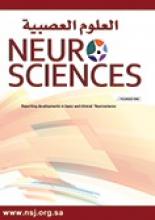Case ReportCase Report
Open Access
Tardive dyskinesia occurring in a young woman after withdrawal of an atypical antipsychotic drug
Mohammed A. Alblowi and Fahad D. Alosaimi
Neurosciences Journal October 2015, 20 (4) 376-379; DOI: https://doi.org/10.17712/nsj.2015.4.20150078
Mohammed A. Alblowi
From the Psychiatry Department, King Khalid University Hospital, King Saud University, Riyadh, Kingdom of Saudi Arabia
MDFahad D. Alosaimi
From the Psychiatry Department, King Khalid University Hospital, King Saud University, Riyadh, Kingdom of Saudi Arabia
MD
References
- ↵
- Goyal R,
- Devi SH
- ↵
- Waln O,
- Jankovic J
- ↵
- Saltz BL,
- Robinson DG,
- Woerner MG
- ↵
- American Psychiatric Association
- ↵
- Kim J,
- MacMaster E,
- Schwartz TL
- ↵
- Schneider SA,
- Aggarwal A,
- Bhatt M,
- Dupont E,
- Tisch S,
- Limousin P,
- et al.
- ↵
- Yoshida K,
- Bies RR,
- Suzuki T,
- Remington G,
- Pollock BG,
- Mizuno Y,
- et al.
- ↵
- Go CL,
- Rosales RL,
- Caraos RJ,
- Fernandez HH
- ↵
- Connor DF,
- Fletcher KE,
- Wood JS
- ↵
- Bhidayasiri R,
- Boonyawairoj S
- ↵
- Bhidayasiri R,
- Fahn S,
- Weiner WJ,
- Gronseth GS,
- Sullivan KL,
- Zesiewicz TA,
- et al.
- ↵
- Richardson MA,
- Bevans ML,
- Read LL,
- Chao HM,
- Clelland JD,
- Suckow RF,
- et al.
- ↵
- Kim J,
- Donovan J,
- Schwartz TL
- ↵
- Woods SW,
- Saksa JR,
- Baker CB,
- Cohen SJ,
- Tek C
- ↵
- Pappa S,
- Tsouli S,
- Apostolou G,
- Mavreas V,
- Konitsiotis S
In this issue
Tardive dyskinesia occurring in a young woman after withdrawal of an atypical antipsychotic drug
Mohammed A. Alblowi, Fahad D. Alosaimi
Neurosciences Journal Oct 2015, 20 (4) 376-379; DOI: 10.17712/nsj.2015.4.20150078
Jump to section
Related Articles
- No related articles found.
Cited By...
- No citing articles found.





